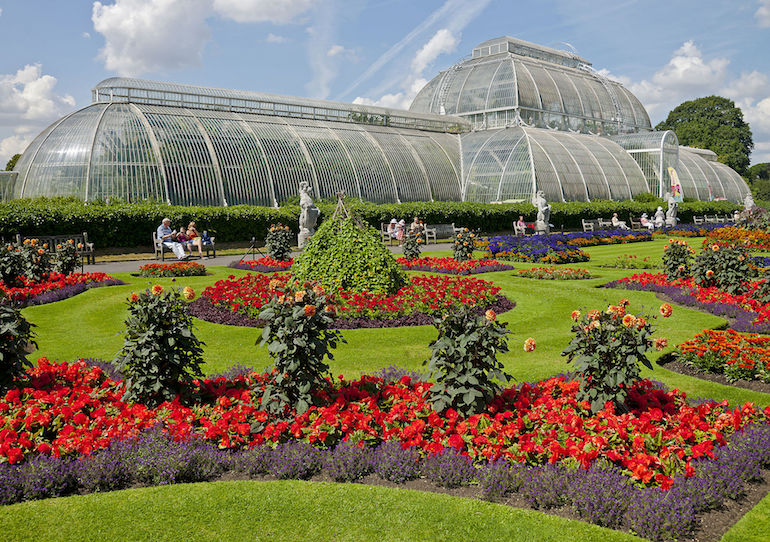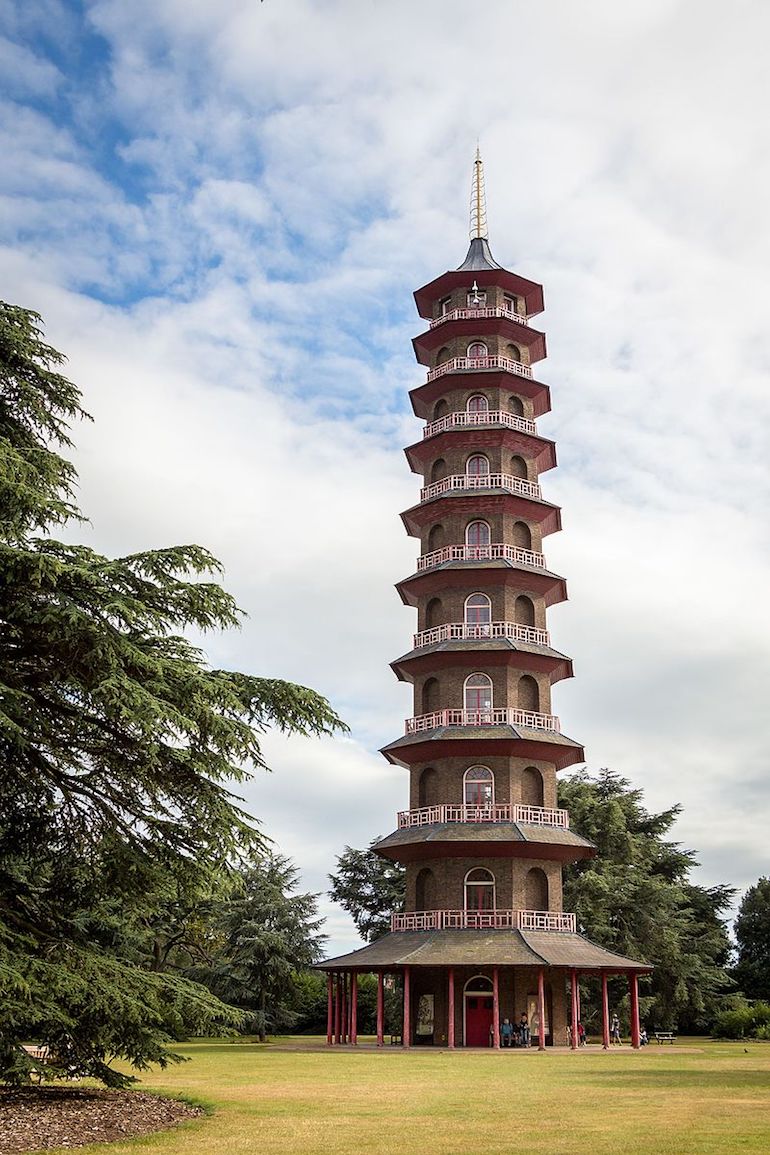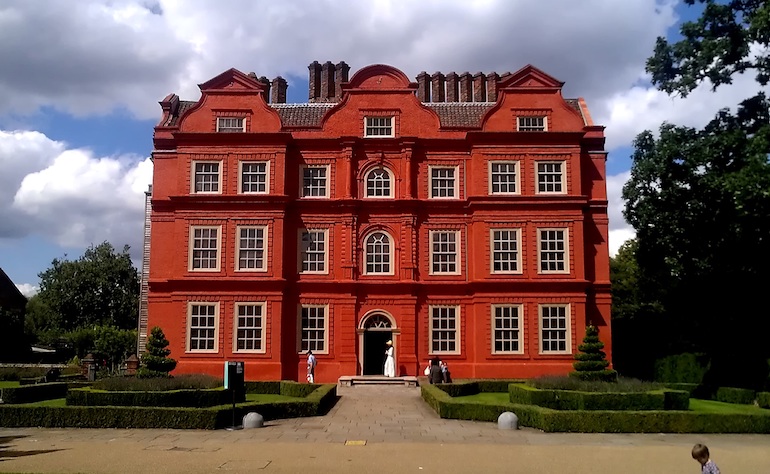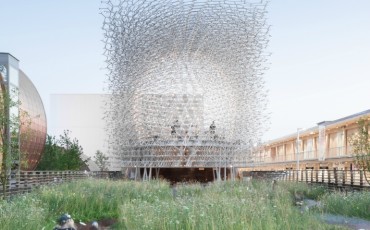The Royal Botanic Gardens of Kew make a wonderful day out away from the hustle and bustle of central London.
Learn 5 new things from Blue Badge Guide Patricia Gentry on:
- How the gardens evolved from hunting grounds to a private royal pleasure garden, and then into a public garden for all to appreciate
- Kew Gardens’ largest champion tree
- The ‘Loneliest Bachelor in the World’
- The smallest of all royal palaces in England
- How Kew Gardens became a clearinghouse for rubber seeds and saved the Amazon Rainforest
 The Palm House and Parterre at the Royal Botanic Gardens of Kew in London. Photo Credit: © Daniel Case via Wikimedia Commons.
The Palm House and Parterre at the Royal Botanic Gardens of Kew in London. Photo Credit: © Daniel Case via Wikimedia Commons.
During the Tudor times, Kew was just a remote village along the River Thames where the royals came to hunt. The first Tudor king, Henry VII, was the Earl of Richmond and owned a palace nearby in Richmond. The history of the actual gardens started only in the 18th century when Frederick the Prince of Wales, son of George II, shared a dream with his wife Augusta to create an exotic garden full of plants brought back from the British colonies.
After the sudden death of Prince Frederick in 1751, the Princess of Wales continued pursuing her dream with other enthusiastic plant-loving advisers, the Earl of Bute and the great architect William Chambers. Chambers went on to design a magnificent Chinese pagoda for her, now called “the Great Pagoda”; a trademark of the Gardens. He also designed an Orangery for Princess Augusta – an area where she could keep her exotic citrus plants warm. The Orangery is still there, but today is a beautiful café where visitors can enjoy English afternoon tea!
In 1760, George III inherited the nearby royal estate of Richmond from his grandfather George II. He went on to combine it with the nine-acre exotic garden created by his mother, Princess Augusta. Subsequently, the Gardens grew from a mere nine acres into a 300-acre estate! This new large garden was called the “Royal Botanic Gardens of Kew” for the first time in 1802.
In the 19th century, the gardens fell into decline. Luckily, Queen Victoria saved them from closure by bequeathing them to the nation in 1837 – the same year she ascended the throne. Thanks to her, the Gardens became public for all to enjoy.

The Pagoda at Kew Gardens in London. Photo Credit: © Rafa Esteve via Wikimedia Commons.
The arboretum’s champion trees
Kew Gardens has an arboretum which spreads over two-thirds of the gardens and counts more than 14,000 trees representing 2,000 species. The collection contains some trees as old as the Gardens themselves, and many cannot be found elsewhere in Britain.
Amongst its champion trees, we count the 40-metre tall coastal redwood Sequoia as the tallest tree at Kew Gardens. It is as high as a 13-storey building.
The largest redwood Sequoia in the world is an incredible 84 metres tall and 11.1 metres wide. Redwoods live usually in California’s Sequoia National Park, which is now a much-protected area. They are ancient trees that can live for up to 3,000 years.
If you are interested in large trees, you may want to combine your visit with a trip to London’s Natural History Museum, where you can see the cut trunk of a 1,300-year-old sequoia tree. Though the trees are strongly protected today, this particular one was cut down to be showcased at the World Exhibition of Chicago in 1893. Someone dated the tree by counting all its rings. Visiting the Natural History Museum, perhaps in combination with Kew Gardens, with a Blue Badge Guide who can tell you the stories, makes for a day well spent. The Natural History Museum is based in South Kensington, only 30 minutes travel time from Kew Gardens.
“The Loneliest Bachelor in the World” is the nickname given to the cycad tree Encephalartos Woodii in the recently restored Temperate House in Kew Gardens. It descends from the only cycad left in the world growing wild in Natal, South Africa. All others are in botanical gardens and like Kew’s example, are clones of this one specimen – so all are male. The tree produces beautiful cones which are highly prized by collectors for their beauty.
A Kew Gardens’ team are now desperately searching in South Africa to find a female cone to make pollination and the survival of this cycad possible. Hopefully, the bachelor will find its match soon!
 A panoramic view of the treetop walkway at Kew Gardens in London. Photo Credit: © Diliff via Wikimedia Commons.
A panoramic view of the treetop walkway at Kew Gardens in London. Photo Credit: © Diliff via Wikimedia Commons.
Kew Palace
This Dutch-looking building was once a private mansion commissioned in 1631 by a wealthy Flemish silk merchant and not a palace until much later. The Hanoverian King George III purchased the building in the late 1700s as a country retreat for his family. He loved spending time away from the limelight and royal duties to live a normal family life.
Sadly this is also the place where the same King George III spent time in isolation towards the end of his life when he suffered from his first serious bout of madness. Away from the public eye, doctors tried to cure the king by administering powerful emetics, leeching and freezing baths.
Kew Palace, the royals’ country house, is also the place where the king’s wife, Queen Charlotte, passed away. Suddenly ill on a journey from London to Windsor, she was taken to the nearby Kew Palace and never left it as she died 10 months later.
The villagers of Kew came to watch the queen’s funeral procession, during which her coffin was taken to Windsor Castle for burial. The cobbled courtyard of Windsor castle was muffled with straw so the by now seriously demented King George III wouldn’t be aware of the death of his beloved wife. Both king and queen had spent many happy times at Kew Palace in their younger days.
 The Dutch House at Kew Palace in southwest London. Photo Credit: © Ethan Doyle White via Wikimedia Commons.
The Dutch House at Kew Palace in southwest London. Photo Credit: © Ethan Doyle White via Wikimedia Commons.
The Rubber plant was first discovered in 1734 in the Amazon Forest of South America (Bolivia and Brazil). It was, however, not until the 19th century that industrialists discovered that if you vulcanised rubber, that is if you treated it with sulphur, you could make products that would retain their flexibility and waterproofing qualities.
This was one of the most exciting inventions of the 19th century. The Great Exhibition of London, organised by Queen Victoria’s consort, Prince Albert, took place in Kensington Gardens in 1851. Amongst its exhibitors was the British textile manufacturer Charles Macintosh, who exhibited the first rubberised raincoat (by sandwiching flattened rubber between two layers of fabric). Queen Victoria thought it was incredibly modern and took a great interest in this product.
Unfortunately, overdemand for rubber soon meant that the forests of South America were being decimated. To tackle this problem, the Royal Botanical Gardens of Kew ordered 70,000 rubber plant seeds, which were first sent from South America to the Gardens, sorted and repackaged and then sent on to India, where many rubber plantations were started and a new economy began.
Kew Gardens is a fun place full of interesting hi(stories), including for families.







Leave a Reply